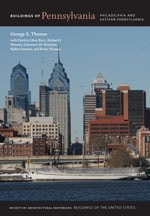
The juxtaposition of contemporary life with industrial culture continued with the late-nineteenth-century Gothic Revival mansion and carriage house for the next generation of the Huston family Abram F. Huston. He would have encountered the work of Cope and Stewardson in his role as a member of the Board of Managers of Haverford College ( DE36), where the architects had recently designed a new classroom building in 1887, and as a member of the Board of Trustees for Bryn Mawr College ( MO9), where they were designing the first of their landmark series of dormitories. For Huston, they designed an immense Gothic mansion of the brooding gray variety that characterized the first round of historically accurate mansions that ended the Victorian era. Its great entrance hall is one of the splendid rooms of Cope and Stewardson's early work, with linenfold paneling revealing their allegiance to the new historicism. The location of the house at the intersection of 1st Avenue and Coatesville's main commercial street represents Huston's role as president of Lukens Iron and Steel Company and follows the model of the closely engaged Philadelphia industrialists who were on hand to meet emergencies, and one suspects because they were deeply interested in their work.

